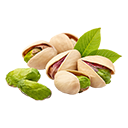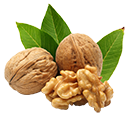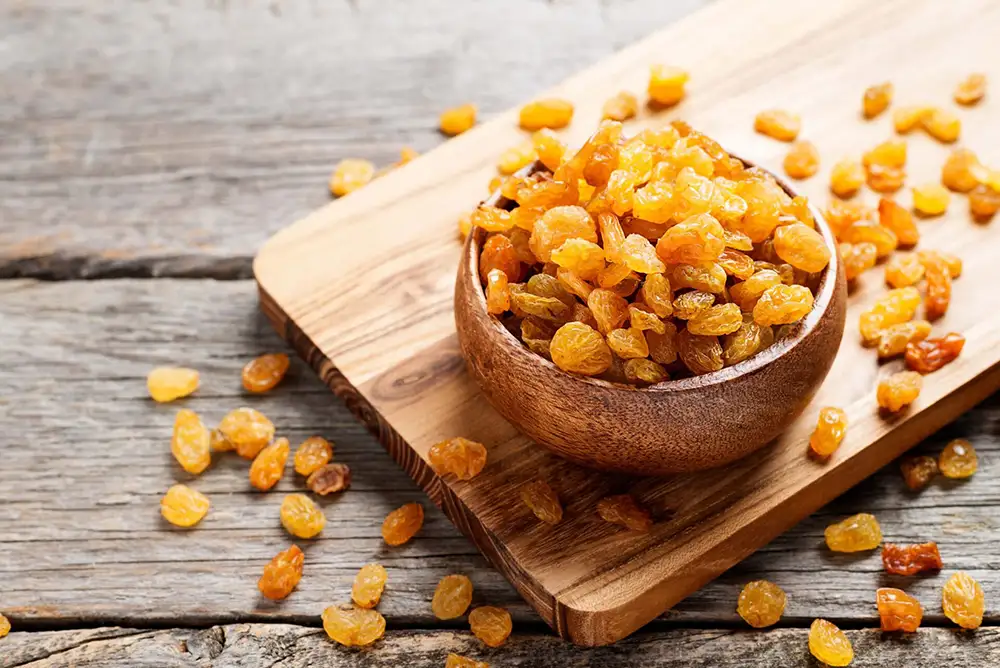الزبيب الذهبي
The USDA provides the following nutrition information for 1/2 ounce (14g) of dark, seedless raisins. A half-ounce is the equivalent of one miniature box.
|
Calories |
42cal |
|
Fat |
0 |
|
Sodium |
3.6mg |
|
Carbohydrates |
11g |
|
Fiber |
0.6g |
|
Sugars |
9.1g |
|
Protein |
0.5g |
Carbs
Raisins have 11 grams of carbs per half-ounce (14g), compared to fresh American-type grapes, which have about 2.5 carbs in a similar serving size of 6 grapes (14.4g). Grapes, depending on the variety, have fewer calories than raisins, but also less fiber. The carb, calorie, and fiber counts in golden raisins are similar to dark raisins. Raisins with seeds provide more fiber, with similar amounts of carbs and calories.
While raisins are high in carbohydrates, their sugar is mostly fructose, which has a lower glycemic index. The glycemic index is a ranking of how much a food would raise your blood sugar compared with pure glucose, which has a ranking of 100. The actual amount any food raises your blood sugar has to do with how glycemic it is, how much of it you eat, and what else you eat with it. The glycemic load attempts to combine these concepts, and some diets use the glycemic load for this reason.
Depending on where you look, the glycemic index of raisins is in the low to moderate range. Keep in mind that glycemic index is a complex topic and individuals can have varying responses to foods. Eating too many raisins can result in a large blood sugar rise in people with diabetes because raisins have a significant amount of carbohydrates per serving.
Fats
Raisins have a negligible amount of unsaturated fat.
Protein
With just under 1 gram of protein per 1-ounce serving, raisins are not a good source of protein.
Vitamins and Minerals
An ounce of raisins provides 4% of your daily needs for potassium. Raisins also contain iron, vitamin B6, vitamin C, magnesium, and calcium.
على الرغم من أن العنب يفقد بعض العناصر الغذائية أثناء عملية التجفيف، إلا أن الزبيب لا يزال مصدرًا جيدًا للمواد الكيميائية المضادة للأكسدة، بما في ذلك البوليفينول والأحماض الفينولية، وكذلك الألياف.
یرتبط بنظام غذائي أفضل بشكل عام
أظهرت دراسة لبيانات المسح الوطني لفحص الصحة والتغذية 2001-2012 أن أولئك الذين تناولوا الزبيب لديهم نظام غذائي عالي الجودة بشكل عام. وتناولوا الفواكه والخضروات الطازجة والحبوب الكاملة أكثر من أولئك الذين لم يأكلوا الزبيب. كان لدى آكلي الزبيب أيضًا وزن أقل في الجسم، وانخفاض مؤشر كتلة الجسم (BMI)، ومحيط خصر أقل، وكانوا أقل عرضة للسمنة أو زيادة الوزن بنسبة 39٪، وكان خطر الإصابة بمتلازمة التمثيل الغذائي أقل بنسبة 54٪ من أولئك الذين لم يتناولوا الزبيب.
يقلل من خطر الإصابة بأمراض القلب
كما تبين أن تناول الزبيب قد يقلل من خطر الإصابة بأمراض القلب.
يدعم ميكروبيوم الأمعاء
الألياف الغذائية الموجودة في الزبيب قابلة للذوبان وغير قابلة للذوبان، وتحتوي على البريبايوتكس، مثل الإينولين. تساعد هذه البريبايوتكس في دعم نمو البكتيريا “الجيدة” في الأمعاء، والتي يمكن أن تساعد في خفض نسبة الكوليسترول، وتحسين عملية التمثيل الغذائي، ووظيفة الجهاز المناعي.
يوفر طاقة سريعة
يحتاج رياضيو التحمل إلى الوقود على شكل كربوهيدرات خلال جلسات التدريب الطويلة والسباقات. يلجأ الكثيرون إلى المضغ الرياضي والمواد الهلامية، لكن الزبيب يمكن أن يعمل أيضًا. أظهرت إحدى الدراسات الصغيرة أنها كانت فعالة مثل حبوب الهلام الرياضية الخاصة في تحسين الأداء الرياضي أثناء التمارين المعتدلة إلى عالية الكثافة.
يحسن صحة الأسنان
بعض العناصر الغذائية الموجودة في الزبيب، بما في ذلك حمض الأوليانوليك وحمض اللينوليك وحمض اللينولينيك، لها خصائص مضادة للميكروبات يمكنها محاربة البكتيريا التي تسبب مشاكل الأسنان، مثل تسوس الأسنان وأمراض اللثة.
Like other dried fruits, raisins are shelf-stable, which makes them easier to store and transport than some other fresh fruits that require refrigeration. You can keep them in an airtight container in a cool, dark place for about a month. After that, they will last longer if stored in the refrigerator.
ويتم تجفيف هذا النوع بالفرن ثم يضاف إليه الكبريت للحفاظ على لونه. وقد تسبب الكبريت في تحول لون الزبيب إلى اللون الأصفر ويجعل طعم الزبيب لاذعا قليلا.

 الفستق
الفستق اللوز
اللوز الجوز
الجوز البرباريس
البرباريس الزبيب
الزبيب الزعفران
الزعفران التين المجفف
التين المجفف تمر كالوت
تمر كالوت تمر بياروم
تمر بياروم تمر زاهدي
تمر زاهدي تمر مزافاتي
تمر مزافاتي تمر استاميران
تمر استاميران تمر الرابي
تمر الرابي